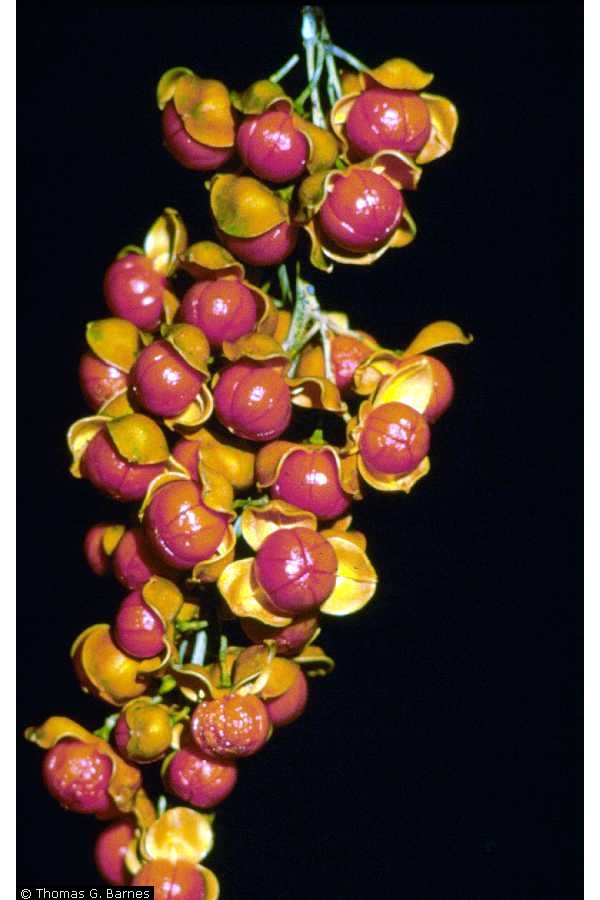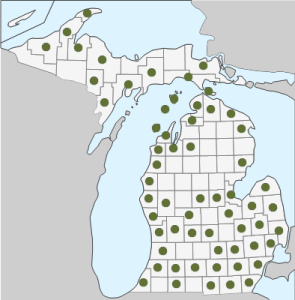 Download PDF
Download PDF
Name: Celastrus scandens L.
 Common Names: American bittersweet, climbing bittersweet, false bittersweet, climbing orange-root, fever-twig, fever-twitch, staff-vine, jacob’s-ladder, waxwork.
Common Names: American bittersweet, climbing bittersweet, false bittersweet, climbing orange-root, fever-twig, fever-twitch, staff-vine, jacob’s-ladder, waxwork.
Family: Celastraceae, The Staff-vine Family
Etymology: Celastrus comes from the ancient Greek word kelastros, a name for an evergreen tree. Scandens is Greek for trailing or climbing (2).
Botanical synonyms:
Celastrus bullata L.
Euonymoides scandens (L.) Medic.
Quick Notable Features:
¬ Twining woody brown stem with pale lenticels; no tendrils
¬ Yellow to orange fruits, often dehiscent to expose bright red to orange arils covering seeds.
¬ Terminal inflorescences
Plant Height: Up to 18m (12).
Subspecies/varieties recognized:
‘Indian Brave’ – Male plant.
‘Indian Maiden’ – Female Plant.
‘Swtazam’ (Sweet Tangerine TM): self-pollinating cultivar.
Most Likely Confused with: Oriental bittersweet Celastrus orbiculatus, an invasive plant (3). The genus is the only vining genus in Michigan with simple alternate crenate leaves.
Habitat Preference: Shade tolerant; prolific grower in many soil types. Grows in disturbed habitats: thickets, riverbanks, roadsides, fencerows, and rocky outcrops. Grows in dry and moist soils (5,8).
Geographic Distribution in Michigan: Native to Michigan; found scattered in upper and lower peninsula counties. Absent from the middle and eastern counties in the upper half of lower peninsula (8).
Known Elevational Distribution: Up to 1500m (14).
Complete Geographic Distribution: Native to North America. Found in the United States and Canada east of the continental divide, with the exception of Florida; extends north to Quebec and south to Texas (1, 17).
Vegetative Plant Description: Perennial liana climbing to 18m high. Leaves are 5-10cm long, simple alternate, ovate to obovate, serrate, having obtuse to rounded bases and apically bearing acuminate tips. Serrations are often rounded. Midvein is prominent with 3 to 4 pairs of ascending secondary veins per side. Petioles are light green. Twigs are brown with pale lenticels (5, 10, 11).
Climbing Mechanism: Plants climb by twining of stem apex; no tendrils or adventitious roots. Plant stems twine dextrally (left to right).
Flower Description: Flowers are white to green and inconspicuous, borne 6 or more in terminal panicles. Plants are typically dioecious, although perfect flowers sometimes are present. Flowers are functionally unisexual and 5-merous. Staminate flowers have 5 stamens the length of petals inserted on the margin of a cup-shaped disk, and a vestigial pistil. Pistillate flowers have vestigial stamens and a well-developed superior ovary. The style is stout and columnar; the stigma is 3-lobed. There are two ovules per locule (10, 11).
Flowering Time: Late spring (May and June) (10, 11) site not specified.
Pollinator: The flowers are bee pollinated (5).
Fruit Type and Description: The fruit is a globose orange capsule, 1cm diameter. When ripe, the capsule splits open to reveal an orange to red fleshy aril covering seeds. Capsules have three valves; each valve contains one or two seeds. Fruits ripen from late August to October and may persist through midwinter (10, 13).
Seed Description: Seeds are 6mm long, ellipsoid, and covered in a fleshy scarlet aril; seed color is unknown (15).
Dispersal Syndrome: Seeds are bird dispersed. Fruits are toxic to humans. However, human dispersal is also prominent as the showy inflorescences are often used in the florist trade. Plants also reproduce by root-suckering (7).
Distinguished by: When distinguishing between C. scandens and C. orbiculatus, floral or reproductive characters are the most reliable. Inflorescences of C. orbiculatus are axillary cymes; those of C. scandens are terminal panicles. When fruiting, the valves of C. scandens are orange, whereas the valves of C. orbiculatus are generally yellow.
Due to the variability of leaf size and shape of C. orbiculatus, leaf morphology is not a reliable character according to Voss (8). However, a recent study (18) suggests differences in leaf morphology are sufficient for plant identification. The most reliable of these is leaf ptyxis (leaf folding in the bud): C. orbiculatus has a conduplicate fold, while that of C. scandens is involute (rolled margin).
The study also suggests that if the length-to-width ratio of the leaf “is greater than or equal to 2, there is a 90% chance of the plant being [C. scandens], while if the ratio is less than or equal to 1.4, there is a 90% chance of it being [C. orbiculatus]….Plants with leaf tips of 1.5 cm or greater have a 90% chance of being [C. scandens], while plants with leaf tips of 0.3 cm or less have a 90% chance of being [C. orbiculatus]” (18).
Other members of the family in Michigan: Celastrus orbiculatus (1), Euonymus (6)
Ethnobotanical Uses: Celastrus scandens was used by native Americans for a wide variety of purposes. Leaves, bark, and roots were used as aids for rheumatism, childbirth pains, gastrointestinal discomfort, skin ulcers, coughs, tuberculosis, toothaches, and even cancer. Inner bark is sometimes cooked into a thick soup in times of starvation. The toxic fruits are used to make poisons (4).
 Phylogenetic Information: Families Celastraceae and Lepidobotryaceae both are members of the order Celastrales. Celastrales belong in the taxa Eurosids I. They form a monophyletic group with the Malpighiales and Oxidales. They are part of the rosids within the eudicots. Celastrales are angiosperms (6).
Phylogenetic Information: Families Celastraceae and Lepidobotryaceae both are members of the order Celastrales. Celastrales belong in the taxa Eurosids I. They form a monophyletic group with the Malpighiales and Oxidales. They are part of the rosids within the eudicots. Celastrales are angiosperms (6).
Interesting Quotation or Other Interesting Factoid not inserted above: Bittersweet can kill host trees by girdling if allowed to reach sufficient sizes (3).
Literature and websites used:
- USDA Natural Resources Conservation Service. 2006. USDA Plants Profile. plants.usda.gov/java/profile?symbol=CESC
- Goodwin, M.S. 2006. Etymology. Purdue University department of Horticulture. www.hort.purdue.edu/hort/courses/hort217/Nomenclature/etymology.pdf
- Heatly, R. 2000. Celastrus scandens – American Bittersweet. Michigan State University Extension. http://web1.msue.msu.edu/msue/imp/modzz/00000311.html
- Hamel, P.B. and M.U. Chiltoskey 1975. Cherokee Plants and Their Uses – A 400 Year History. Sylva: Herald Publishing.
- Plants for a Future. http://www.ibiblio.org/pfaf/cgi-bin/arr_html?Celastrus+scandens
- APG II 2003. An update of the Angiosperm Phylogeny Group classification for the orders and families of flowering plants: APG II. Botanical Journal of the Linnean Society 141(4): 399- 436.
- Dreyer, G.L., L. Baird, and C. Fickler 1987. Celastrus scandens and Celastrus orbiculatus: Comparisons of reproductive potential between a native and an introduced woody vine. Bulletin of the Torrey Botanical Club 114(3): 260-64.
- Voss, E.G. 1985. Michigan Flora Part II. Ann Arbor: University of Michigan Press.
- Holmgren, N. H. 1998. The Illustrated Companion to Gleason and Crnoquist’s Manual. New York: The New York Botanical Garden Press.
- Gleason, H.A. and A. Cronquist. 1991. Manual of Vascular Plants of Northeastern United States and Adjacent Canada. New York: The New York Botanical Garden Press.
- Cooperrider, T.S. 1995. The Dicotyledons of Ohio – Part 2. Linaceae through Campanulaceae. Columbus: Ohio State University Press.
- Fernald, M.L. 1950. Gray’s Manual of Botany, 8th edition. New York: American Book Company.
- Young, J.A. and C.G. Young 1992. Seeds of Woody Plants in North America. Portland: Dioscorides Press.
- TPID 2006. Texas Plant Information Database. Texas Parks and Wildlife. http://tpid.tpwd.state.tx.us/species_report.asp?species=119
- Gleason, H.A. 1963. Illustrated Flora of the Northeastern United States and Adjacent Canada, Volume 2. New York: Hafner Publishing Company, Inc.
- Hou, D. 1955. A revision of the genus Celastrus. Annals of the Missouri Botanical Garden 42:215-302.
- Foster, C. and C. Hamel 2006. Rare species surveys of the Manitoba Canada Data Centre, 2005. MS Report 06-01. Manitoba Conservation Data Centre, Winnipeg, Manitoba, 43pp.
- Leicht-Young, S.A., N.B. Pavlovic, R. Grundel, and K.J. Frohnapple 2007. Distinguishing native (Celastrus scandens L.) and invasive (C. orbiculatus Thunb.) bittersweet species using morphological characteristics. Journal of the Torrey Botanical Society 134(4): 441-450.
Image Credits (all used with permission):
1) Image of leaves © Robyn J. Burnham, University of Michigan.
2) Image of fruiting specimens courtesy of Thomas G. Barnes @ USDA-NRCS PLANTS Database
3) Image of seeds courtesy of Steve Hurst @ USDA-NRCS PLANTS Database
4) Species distribution map, derived from the Michigan Flora Online
Prmary Authosr: Susu Yuan and John Bradtke, with editing and additions by Robyn J. Burnham and ReBecca Sonday
For additional information on Michigan Plant Diversity web pages please contact Robyn J. Burnham via email: rburnham“at”umich.edu